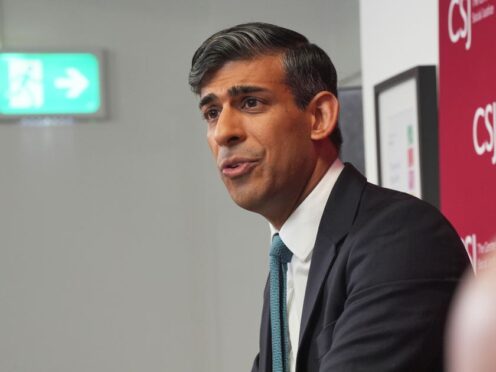The Conservatives will keep the two-child benefit cap if they win the next election, the Prime Minister has said.
Charities have called for the abolition of the cap, which restricts Universal Credit support to two children in a family, pointing to record levels of child poverty in the UK.
Writing in The Sun On Sunday, Rishi Sunak committed his party to keeping the policy.
He said: “Working families do not see their incomes rise when they have more children. Families on benefits should be asked to make the same financial decisions as those supporting themselves solely through work.”
The commitment follows Mr Sunak’s speech on Friday in which he set out reforms of the welfare system to reduce the number of people receiving benefits and bring spending down.
The number of people claiming at least one health-related benefit has soared since the pandemic, with one in 10 people now receiving support, according to the Institute for Fiscal Studies.
In his Sun On Sunday article, the Prime Minister said: “There is nothing compassionate about consigning people who could work to a life trapped on benefits.
“We will change the system so that we are giving people a hand up rather than a hand-out.”
Campaigners have criticised Mr Sunak for using “hostile rhetoric” and launching a “full-on assault on disabled people” with his plans for welfare.
Responding to Mr Sunak’s commitment to the two-child cap, Child Poverty Action Group chief executive Alison Garnham said: “With child poverty at a record high, the Prime Minister has now clearly decided that making kids poor is his political priority.
“After Covid and the cost-of-living crisis, struggling families need a helping hand not another kick in the teeth.
“The two-child limit makes life harder for kids, punishing them for having brothers and sisters. It’s time to scrap this nasty policy.”
Last week also saw the launch of a campaign to lift a million children out of poverty by 2030, backed by human rights lawyer Cherie Blair and former children’s commissioner Anne Longfield.
Scrapping the two-child benefit cap features among the campaign’s demands, a policy supported by the current children’s commissioner Dame Rachel de Souza.
Official statistics published in March showed child poverty hit record highs last year, with 4.33 million children living in households in relative low income in the year to March 2023.
For a couple with two children, this meant a combined weekly income of less than £530 after housing costs.
One in four children are considered to be in absolute poverty, defined as households below 60% of the median income in 2010/11, uprated by inflation, equivalent to less than £485 a week after housing costs for a couple with two children.
